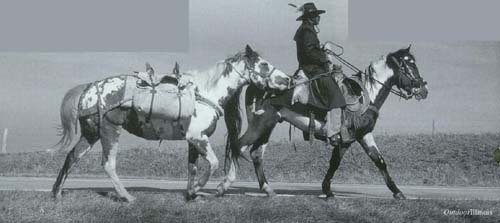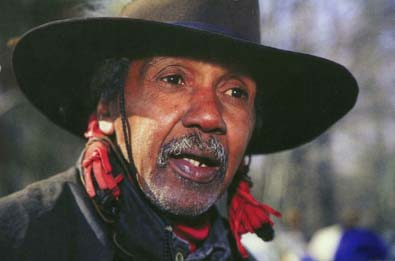|
WolfRider
As he retraces his Cherokee ancestors'journey from North Carolina to Oklahoma, J. Samuel Burton is creating a renewed awareness of the Trail of Tears.
BY Liz PENSONEAU
PHOTOS BY ADELE HODDE
By his own admission, had he been barefoot and without adequate clothing, J. Samuel Burton probably wouldn't have been seen riding his stallion Tibiano Cherokee and leading his pack horse Ghost Dancer alongside Route 146 east of Vienna on a blustery winter day in February. He wouldn't have made it that far without turning back.
Burton, 60, a retired engineer from Evanston, has spent the past several months fulfilling a childhood promise to his Cherokee grandfather that he would someday retrace the Trail of Tears journey. In July 1999, Burton, also known as WolfRider, gathered his equestrian gear and Native American attire and began a horseback journey from Evanston across Wisconsin, Iowa, Nebraska, South Dakota and Kansas to the starting point for his
official Trail of Tears journey, Tahlequah, Okla.
Riding the trail in reverse, Burton is retracing the original trek that, in the winter of 1838, took thousands of Cherokee Indians from their homes and farms in the southeastern United States to walk in caravan to a reservation in the Oklahoma plains. It was a forced journey, compelled by the Federal Indian Removal Policy, and marked with indignities, pain, suffering and death. An estimated 4,000 lives, nearly 25 percent of the Cherokee Nation, were lost as a result of the ordeal.
According to a written account in the "Southernmost Illinois Visitors Guide," the journey covered 1,000 mites, and the Cherokee were wearing only light clothes and carrying a few blankets. Medical care was nearly non-existent. Only the very old, sick and small children could be carried in wagons or ride on horseback. More than 8,000 were on foot. most without shoes or
Of his horses, WolfRider says: "To others they are horses. To me, they are my companions, friends and loving family

|
8 OutdoorIllinois
|

J.Samuel Burton, also known as WolfRider, crossed southern Illinois in February on his way to Cherokee, N.C., the origin of the Trail of Tears.
|
moccasins. They crossed Tennessee and Kentucky, arriving in Golconda
on or about Dec. 3, 1838.
To cross the river from Kentucky to Golconda, the Cherokee had been forced to pay a hefty $1 per head for passage on the Berry Ferry at a time when the going rate was 12 1/2 cents for a Conestoga wagon and all that could be carried. To make matters even worse, a small pox epidemic, cholera and whooping cough had spread throughout the tribe, claiming lives and causing townspeople to insist the tribe keep its distance from towns and villages. However, the Buel family of Golconda is said to have compassionately shared its pumpkin crop with the Cherokee.
The Buel home, which was built in 1837, still stands today south of the Golconda Courthouse, and was a scheduled stop where Burton rested his horses and visited with local residents.
Burton's journey through southern Illinois was coordinated by the Illinois State Chamber of Commerce. His overnight accommodations between Vienna and Golconda were provided by the Department of Natural Resources at a Dixon Springs State Park group camp cabin. For the most part, Burton said he usually spends his nights at the roadside or in the field of a willing farmer.
One of the most emotional stops for WolfRider was south of the state park at the Field Cemetery, the burial ground for the Cherokee Indians who did not survive the march. Here, the reverse side of a large granite marker "In honor of the Cherokee people who died on the forced march of the Trail of Tears during the winter of 1838" proclaims the Legend of the Cherokee Rose:
"When the Trail of Tears started in 1838, the mothers of the Cherokee were grieving and crying so much they were unable to help their children survive the journey. The elders prayed for a sign that would lift the mothers' spirits to give them strength. The next day, a beautiful rose began to grow where each of the mother's tears
fell. The rose is white for their tears. A gold center represents the gold taken from Cherokee lands and seven leaves on each stem for the seven Cherokee clans. The wild Cherokee rose grows along the route of the Trail of Tears into eastern Oklahoma today."
One thing that has concerned Burton has been the discovery that there are no markers on either the Illinois or Missouri side of the Mississippi River to commemorate the Trail of Tears crossing. Burton has volunteered to pay for the signs, but says he needs assistance from others to make the proper contacts. To help Burton with this project or to learn more about his trip, visit his website:
http://www.dailynews.net/ads/wolfrider/journal.html.
|
April 2000 9
|

